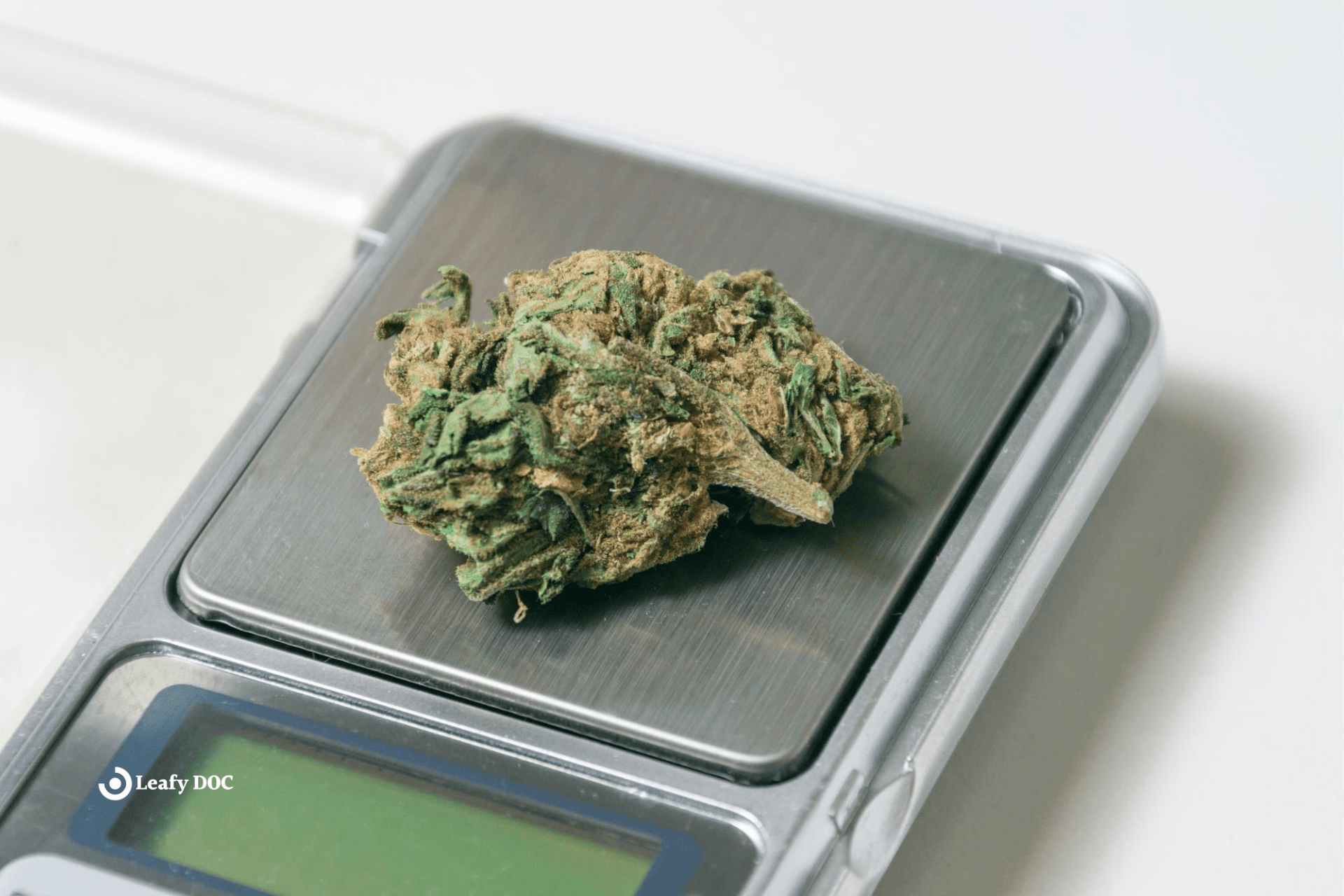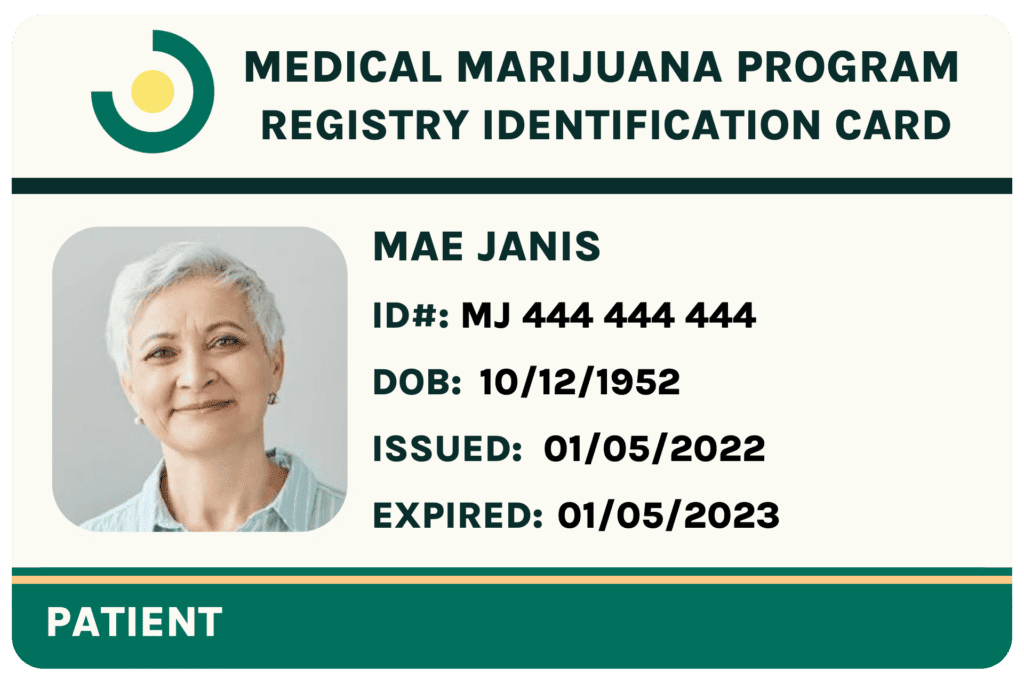A Comprehensive Guide to Cannabis Measurements
by Haley Mills · May 25, 2023
Learn the basics of cannabis measurements and weights with this comprehensive guide! Find out the differences between ounces, grams, and more to make sure you get the right amount every time.

Let’s break down the most common measurements, weights, and terms used when purchasing medical marijuana. Continue reading to learn the basics of buying the right amount of your favorite cannabis products.
Cannabis Flower Measurements
Here, we’ll begin with the smallest unit of weed measurements and work our way up from there.
Gram
A gram is a small metric unit that equals one-thousandth of a kilogram. It’s ideal for those who want to buy smaller amounts of weed to try a new strain or because of low consumption rates. A gram is the only cannabis measurement unit that doesn’t relate to ounces regarding cannabis quantities.
How Much Does a Gram of Cannabis Cost?
The price of a gram typically ranges from $10 to $20, depending on factors like your location, the dispensary’s pricing strategy, and the quality of the cannabis. Strains with higher THC levels or unique terpene profiles may cost more, while lower-tier options tend to be more affordable.
You may also hear a gram referred to by slang terms like “dub sack” or “20-sack” in cannabis culture. Knowing these terms and price ranges can help you make more informed decisions at the dispensary.
Eighth
An eighth refers to an eighth of an ounce or three and a half grams of cannabis flower. For many users, an eighth of weed is affordable and a perfect amount for weekly use. The eighth is the most common weed weight sold in legal U.S. dispensaries.
From an eighth ounce of cannabis (about 3.5 grams), you can roll around three full-gram joints or seven standard half-gram joints. If you prefer using a bong or pipe, this amount can pack roughly six bowls, making it a versatile option for both occasional and regular users.
An eighth typically contains two to four buds, though it may include smaller “popcorn” buds, shake, or dust, depending on quality. This makes it a versatile option for trying new strains without committing to a large amount.
The price of an eighth generally ranges between $30 to $70, depending on strain type, THC concentration, and overall bud quality. For light users, it can last up to two weeks, while more frequent consumers may go through it in just a few days.
Quarter
A quarter ounce of marijuana weighs around seven grams, making it a practical choice for moderate users. You might hear it referred to as a “quad” or even a “dime bag,” though the latter can vary in meaning depending on the region.
Physically, the size of a quarter ounce depends on the density of the cannabis buds—fluffier buds may look like more, while denser nugs can appear smaller.
From a quarter ounce of cannabis (around 7 grams), you can roll about 7 full-gram joints, 14 half-gram joints, or up to 30 one-hitters. How long it lasts depends on your usage, but it’s a flexible amount that suits both casual and regular users.
How Much Does a Quarter Ounce Cost?
The price of a quarter ounce varies based on strain quality, location, and even the time of year. In some areas, you might find shake weed or lower-tier cannabis for as low as $20 during harvest season, while top-shelf flower in cities like Los Angeles could cost up to $100.
If you’re paying more, it’s usually for premium, organically-grown cannabis from reputable farms. Always compare pricing with quality to ensure you’re getting the best value.
Half
A half refers to 14 grams of cannabis flower, or half an ounce. It’s a popular choice for regular users who want enough supply to last a few weeks. Depending on how it’s used, a half-ounce can yield around 25–30 joints and may last up to a month or more for moderate consumers.
If you smoke one generously packed joint a day, this amount could cover an entire month. For lighter users who only take a few bowls per week, a half-ounce might even last up to two months, making it a practical option for both steady and occasional smokers.
In dispensaries, this amount is often sold in 14-gram packs and may be called a “half O,” “half zip,” or “half-lid”, depending on regional slang. It offers a balance between cost-efficiency and quantity, especially for those who have found a favorite strain.
How Much Does a Half-Ounce Cost?
The average price for a half-ounce ranges between $90 and $160, but this can vary based on several factors:
- Strain potency and rarity — Higher THC or exotic terpene profiles typically cost more.
- Dispensary location — Regions with limited access or higher demand often have elevated prices.
- Product quality — Top-shelf, well-cured buds usually command higher rates than lower-tier options.
If you’re new to a strain, it’s best to sample a gram first. But once you find something you enjoy, buying in bulk—like a half-ounce—can be more economical, especially when dispensaries offer tiered pricing or special deals.
How Many Joints Can You Roll from a Half-Ounce of Weed?
A half-ounce of cannabis weighs about 14 grams, which can yield roughly 28 standard joints if each contains 0.5 grams of weed. If you prefer thinner 0.3g joints, you could roll up to 45–46, while larger 1-gram joints will give you about 14 total. The exact number depends on your rolling style and joint size preferences, so results can vary.
Ounce
An ounce contains about 28 grams of cannabis flower and is commonly referred to as a “zip” or “O” because it fits neatly in a ziplock bag. For many, this is the largest amount legally allowed for purchase at one time from a dispensary.
An ounce can produce approximately 28 standard one-gram joints or up to 80+ smaller joints, depending on how it’s rolled. It’s a great choice for regular users, those making edibles, or medical marijuana patients looking to save money by buying in bulk.
Depending on your habits and consumption method, an ounce of cannabis can last anywhere from one week to over a month. If you’re only taking a couple of bong rips each week or using your stash to make cannabis edibles, that ounce could stretch to four to six weeks or even longer. How long it lasts truly depends on how often and how much you use.
Pound
A pound of cannabis equals 453 grams or 16 ounces and is rarely purchased by individual consumers. This amount is typically handled by growers, dispensaries, and commercial distributors for legal sale and supply purposes.
To put it in perspective, a pound of weed is enough to roll 453 large joints—one per gram—or twice as many if you prefer smaller 0.5-gram joints. If you’re packing bowls, you could easily fill over 1,000. For most people, this is far beyond personal use; even daily consumers would find it difficult to get through a full pound before the quality drops. Most premium cannabis maintains its freshness for about six months, after which it can dry out, lose potency, or risk exposure to mold and moisture.
Most states set the personal possession limit at one ounce, making it illegal to possess a full pound of weed in many places—even where cannabis is recreationally or medically legal. Always check local laws before considering large quantities.
The average cost of a pound of weed is around $1,600, though this can vary based on location, strain quality, and market demand.
How Many Joints Can You Roll from a Pound of Weed?
A pound of cannabis equals 453 grams, which means it can produce a massive number of joints depending on how you roll them. If each joint contains 1 gram of weed, you can roll about 450 joints from a single pound. If you prefer smaller 0.5-gram joints, that number jumps to around 900.
Your exact total will depend on your rolling style, the size of the rolling paper, and how tightly you pack each joint. Still, this gives a useful estimate for anyone curious about bulk cannabis usage.

Pricing per Weight
Prices for cannabis can vary greatly depending on your location, dispensary, strain quality, and how the weed was grown (e.g., indoor vs. outdoor). Many dispensaries have shelf tiers, offering budget-friendly options alongside premium, top-shelf strains. For example, an eighth of high-quality cannabis can cost significantly more than a standard or shake option.
Cannabis is typically sold pre-packaged, with the weight clearly listed on the label. Still, if you’re curious or want extra assurance that you’re getting what you paid for, it’s smart to verify your cannabis weight at home.
How to Verify Weed Weight at Home
- Use a digital scale: This is the most accurate way to measure. If you’re a coffee or kitchen scale owner, you may already have the right tool.
- Use visual comparisons: No scale? Try comparing your weed to everyday fruits:
- 1 gram ≈ grape
- 3.5 grams (eighth) ≈ kiwi
- 7 grams (quarter) ≈ apple
- 14 grams (half-ounce) ≈ blood orange
- 28 grams (ounce) ≈ coconut
- 1 pound ≈ large watermelon
By understanding pricing factors and knowing how to visually estimate cannabis weight, you can shop smarter and ensure you’re getting fair value for every purchase.
Depending on your location, strain, and quality, an ounce typically costs between $160 to $350 in U.S. dispensaries. Bulk buying often offers better value per gram compared to smaller quantities.
Understanding the Grams-to-Ounces Discrepancy
If you’re crunching the numbers, you might notice something odd: multiplying 16 ounces by 28 grams gives you 448 grams per pound, yet a true pound weighs about 454 grams. What’s up with that?
It all comes down to the difference between metric and imperial measurements. An ounce actually weighs about 28.35 grams, not a flat 28. When cannabis weights are rounded for simplicity—28 grams per ounce, 16 ounces per pound—it’s mainly for convenience in retail and everyday conversation. The slight gap is a result of rounding down to keep things easy, not because your dispensary is shorting you.
So, while the labels and lingo lean on neat numbers like “28 grams per ounce,” the real math (thanks to the metric/imperial mix) always leaves a fraction behind. It’s simply a quirk of converting between these two systems—nothing nefarious, just a bit of old-school measurement meets modern marketplace.
Concentrates
Marijuana wax results from a process known as extraction, which involves THC from a marijuana plant being packed together into a substance that is as close as possible to pure THC. Depending on this method, the concentrate can vary in texture and potency but is most often thick, sticky, and light yellow to amber in color.
Cannabis wax can contain up to ninety percent THC cannabinoids and offer a unique experience for cannabis users. It is ideal if you have a severe medical condition and look for quick relief from chronic pain. Different types of wax each have their benefits and risks depending on personal preference, so we recommend trying each to find what is right for you.
Cannabis concentrates contain high amounts of THC and have been popular among consumers in recent years. Concentrate weights are similar to flower but are typically packaged only in half-gram and gram quantities. For reference, a half-gram of concentrate is similar to a medium-sized seed, and a gram is comparable to a lighter.
Edibles
Edible marijuana includes any type of CBD or THC food or drinks that you can ingest. You can make medical cannabis edibles at home and there are also gummies, candies, brownies, and other edible cannabis products at dispensaries in legal states. Edibles often take longer to kick in, but they produce a relaxing body high that is helpful for some migraine sufferers.
Marijuana edibles for medical use do not produce any other known severe side effects. Some people fear that it might cause too intense of a high, and others have reservations about its legality, considering that marijuana is federally illegal in the United States. It’s crucial to brush up on local laws and choose a high-quality product for migraine treatment and pain relief.
The recommended dose for edibles is one to five milligrams of THC, especially for novice users. That’s likely to be a small piece of an edible as many are twenty to twenty-five grams each. A lower dose, even for experienced users, is recommended because there’s not much benefit to taking a significant amount. Medical marijuana patients typically use between five and twenty mg, with ten mg being the average. After establishing your desired dose and effects, you can experiment with a higher amount if you wish.
Are Edibles Better Than Smoking Weed?
It depends on your preferences. Edibles take longer to kick in (30 minutes to 2 hours), but the effects last 4 to 8 hours. Smoking weed, on the other hand, provides faster effects that fade within 1 to 3 hours.
Edibles offer a smoke-free option, which may be better for your lungs, and are also more discreet—they leave no strong odor and look like regular snacks. They also provide more precise dosing, especially helpful for medical cannabis users. However, if you prefer immediate relief, smoking may still be your go-to method.
Slang Terms
Since cannabis has been sold on the illegal market for decades, users have developed various slang terms to describe different weed measurements. Below, we define the most common street terminologies.
Dime
A dime is usually a very small amount of cannabis. A dime bag will typically weigh a gram or even out to approximately ten dollars worth of cannabis.
Dub
A dub sack typically describes two grams or twenty dollars worth of cannabis.
Slice
A slice (think Pizza) refers to a quarter of an ounce of bud. It gets its name because it is a perfect “slice” of pizza’s worth of green.
Zip
An ounce is often referred to as a “zip” because it fits well in a ziplock bag and is transfered in those as well.
QP
A “QP” is a quarter-pound of weed or four ounces in weight.
Pack
A pack is a pound of weed, given its name because they were known to be transported in turkey bags.
Reference Guide
Here is a quick and easy weed measurement chart to compare standard terms with their weed weights in grams:
Imperial Units Metric Units
- Eighth (1/8) ounce 3.5 grams
- Quarter (1/4) ounce 7 grams
- Half (1/2) ounce 17 grams
- One (1) ounce 28 grams
- Pound (16 oz) 448 grams
Microdosing Medical Cannabis
For medical marijuana patients, microdosing can be appealing as many medical patients are not looking to feel high all day long, they are looking for assistance in managing and relieving symptoms and pain from their conditions. In the case of pain management for example taking a small amount periodically throughout the day can keep long-term, acute, or severe pain somewhat under control.
Rather than taking very high doses repeatedly microdosing is an option you have a very controlled and mellow experience while benefiting from cannabinoids. Patients can work with their medical providers as well as use the same process of hands-on testing to determine their optimal microdose.
There is no specific rule or chart that can determine what the right amount of a microdose of cannabis for each individual person is. It is a personal process that requires a little bit of hands-on research. When attempting to microdose a cannabis product it is a good idea to start small and keep a written record of how one feels after each microdose. Through this system of trial and error, one will determine what microdose they feel best about and then how often they will need to take each microdose.
Some people may find that taking one or two a day is enough for them, others may want to take a small dose every couple of hours throughout their day. Cannabis use is a very personal process and that goes as well for microdosing.
Tips for Choosing the Right Amount for You
To complete our comprehensive guide on standard cannabis measurements, here are a few tips for purchasing the amount that fits your lifestyle.
- If you are looking to try a new strain or cannabis product, we recommend starting small with a couple of pre-rolls or just a gram or two. This will give you an idea of its effects on your mind or body.
- If you’re smoking weed for the first time, it’s best to start slow. Begin with a single puff or a small pre-roll, and choose a strain with around 12–15% THC for a milder experience. This helps you ease into cannabis without feeling overwhelmed.
- If you’ve found a strain or cannabis product that works well for you, try buying a half or a full ounce and storing it in an airtight container for long-term use.
- Purchasing a larger quantity can sometimes lead to significant savings for medical marijuana users. Still, you must know your legal limits per the prescription in some states, so read up on local laws first and be sure to ask your budtender for deals when you go to purchase cannabis.
- The average joint contains around half a gram of cannabis. This can be a good guideline for how much you consume regularly.
A half-ounce of cannabis equals 14 grams and is a popular amount for regular users who want to save money by buying in bulk. Depending on your habits, it can last up to a month if you smoke one generously sized joint per day, or stretch to two months if you only enjoy a few bowls each week. On average, you can roll around 30 joints from a half-ounce.
Prices typically range between $90 and $160, depending on factors like strain quality, THC or CBD levels, and where you live. If you’re new to a strain, it’s wise to sample a single gram or pre-roll before buying a larger amount. Once you’ve found a favorite, purchasing a half-ounce is a practical way to stock up and cut down on dispensary trips.
Is Buying in Bulk More Cost-Effective?
Once you’ve found a strain that works for you, purchasing a larger quantity, like a half or full ounce, can be more economical than buying smaller amounts each time. At dispensaries across the U.S., the cost of an ounce typically ranges from $160 to $350, depending on the strain, quality, and your location. Medical marijuana patients often enjoy reduced taxes on cannabis purchases, making bulk buying even more affordable. Just be sure to stay within your legal possession limits and store your stash in an airtight container to preserve freshness.
Understanding Cannabis Measurements and Legal Limits
In the U.S., cannabis is typically measured in grams, even though most other products use the imperial system. One ounce equals about 28 grams, and a pound contains 16 ounces, or roughly 453 grams. While dispensaries and commercial growers may handle cannabis in pounds, most state laws limit personal possession to far smaller amounts.
For example, New York allows adults to carry up to three ounces of cannabis, while some states set the limit at just one ounce. Carrying more than the legal amount—even by mistake—can lead to penalties, even in states with legal cannabis programs.
To stay compliant, always check your state’s possession laws and consult your budtender if you’re unsure how much you can buy or carry. Understanding basic weed measurements helps you avoid legal trouble and make smarter buying decisions.
Why Weed Measurement Matters
Understanding how cannabis is measured—by grams, eighths, quarters, and ounces—helps you avoid surprises at checkout and ensures you get what you pay for. Whether you’re shopping in-store or online, knowing these standard units will help you budget better and choose the right amount for your needs.
Benefits of Having a Medical Marijuana Card
Getting a medical marijuana card offers several key advantages. Patients gain access to higher potency strains and specialized cannabis products not available to recreational users. Many states allow larger purchase and possession limits for cardholders, along with legal protections that can ease concerns around cannabis use. Perhaps most notably, medical users often save up to 40% on taxes and enjoy exclusive discounts at dispensaries. You’ll also receive expert dosing guidance from healthcare providers who specialize in cannabis-based treatment plans.
Frequently Asked Questions
How can I weigh weed without a scale?
You can estimate weed weight by comparing it to common fruits. For example, 1 gram is roughly the weight of a grape, 3.5 grams (eighth) feels like a kiwi, 7 grams (quarter) like an apple, 14 grams (half-ounce) like a blood orange, and 28 grams (ounce) is similar to a coconut. While not exact, these comparisons help make rough at-home estimates without a scale.
How many grams of weed should I smoke per week?
There’s no one-size-fits-all answer. It depends on your tolerance, purpose, and how often you consume. Beginners may start with half a gram over several days, while regular users might smoke a few grams per week. Keep track of how you feel and adjust gradually based on your body’s response.
How much cannabis should I smoke per week?
There’s no set amount; your ideal cannabis dosage depends on your reason for using it. Some people smoke daily to manage chronic pain, while others may only need a joint or two per week to relax. A helpful approach is to track how much you’re using and how it affects you. Over time, you’ll discover the minimum effective dose that gives you relief without unwanted side effects. If unsure, start low, go slow, and adjust based on your personal experience.
Last Updated: August 11, 2025
Get Approved for Your Medical Marijuana Card in Minutes!

Get Your Medical Card
Connect with a licensed physician online in minutes

Like This Article?
Share with your friends
Table of Contents
Keep Reading
-
Unlocking Calm: How Medical Marijuana Aids Anxiety And Patient Access
Unlock the secrets to true calm with medical marijuana for anxiety. Learn how this powerful treatment can improve patient access and alleviate anxiety symptoms. Click here to find out more!
-
Using Cannabis Tinctures For Relaxation And Stress Relief
Unwind naturally with cannabis tinctures for relaxation and stress relief. Learn how to use this powerful remedy in our ultimate guide and say goodbye to stress today!
-
Revitalizing Your Skin With CBD For Wellness
Transform your skincare routine with CBD for wellness benefits. Revitalize your skin and experience the amazing CBD skincare benefits today!



